Latest Blogs
Managed IT
Ramsha Khan
Jul 15, 2025
Why Small Businesses in the USA Need Managed IT Services in 2025
Read More...

Why Small Businesses in the USA Need Managed IT Service...
Running a small business in 2025 means balancing everything all at once, from tight budgets, fast-changing technology, to increasing cybersecurity threats. From the startup to maintaining customer satisfaction to keep a workable business, you would rather not have to worry about anything else: security for your systems and backup of your data.
Which is where Managed IT services for small businesses come in. Taking care of all your tech needs, it lets you keep your eyes on growth and not glitches.
Keeping it simple, managed IT services mean outsourcing your company’s technology needs to a dedicated team of IT professionals, also known as Managed Service Providers (MSPs). It can either be fully managed IT services or co-managed IT services. From managing networks to data security, HIPAA compliant cloud storage, hardware support, and 24/7 monitoring, they do it all.
In 2025, IT support for small businesses has become smarter, faster, and more affordable. Thanks to better infrastructure and competition, even startups can now afford enterprise-level IT support.

As your business grows, your once-simple IT setup may start to feel chaotic and hard to manage. Adding more people, tools, and systems can create challenges like:
This is where Managed IT services for small businesses can make a big difference. With affordable managed IT services in the USA, you can get expert IT support for small businesses in 2025 and beyond, helping you reduce costs, fix issues faster, and scale smoothly as you grow.

Here are just a few reasons small businesses are turning to affordable managed IT services in the USA this year:
Hackers aren’t just targeting big corporations anymore. In fact, cybersecurity for small businesses in the USA is now more critical than ever. Ransomware, phishing scams, and data breaches are becoming more common and more costly.
A managed IT team helps monitor your systems 24/7, patch vulnerabilities, and protect sensitive data, so you don’t have to worry about your business being the next target, whether you’re looking for cybersecurity solutions for healthcare, real estate, or any other industry.
Hiring an in-house IT team is expensive. Salaries, benefits, training, it adds up fast. On the other hand, managed IT cost for small businesses is predictable and scalable. You pay for what you need, nothing more.
This is especially useful for startups that have cloud migration and want quality tech support without the overhead. Outsourced IT for startups in the USA is a growing trend because it’s smart budgeting.
Downtime is a killer for small businesses. Lost sales, frustrated customers, and delayed operations can really hurt.
With IT support for small businesses in 2025, proactive monitoring and fast troubleshooting keep your systems running smoothly, so you don’t lose time or money.
Let’s face it: keeping up with technology is tough. With managed IT services, you get access to the latest tools, software development trends, and top-tier expertise, without having to learn it all yourself.
They handle updates, upgrades, and even help with strategic planning for tech investments. That’s a big benefit of managed IT for SMBs looking to stay competitive.
Growing fast? Or maybe you’re a seasonal business that only needs extra support during peak months? Managed IT services scale with you.
That flexibility is a big win, especially for small teams that need to stay lean and agile.
Cloud Managed Services Providers (MSPs) offer more than just tech support; they help small businesses run smarter, smoother, and more affordably. Here’s how:
Whether you’re looking for Managed IT services for small businesses, or are in healthcare IT support services in Dubai, IT support for small businesses in 2025, or affordable managed IT services in the USA, MSPs provide smart, scalable, and cost optimized solutions to help your business thrive.
We do understand that doing anything today feels like a gamble. But in 2025, affordable managed IT services in the USA are more reliable, customizable, and business-friendly than ever.
Think of it as having your own tech department, without the HR headache. Whether you run a small law firm, a local coffee shop, or an eCommerce brand, managed IT services for small businesses make sure you’re supported behind the scenes.
In 2025, ignoring your IT needs is no longer an option. Tech problems aren’t just annoying; they can be damaging. With the right company working on your IT infrastructure, you’ll get the best of services. Whether you’re looking to save money, improve security, or simply get some peace of mind, managed IT services for small businesses are a smart move.
So don’t wait for a crisis to make a change. Start exploring your options today, and let the MSP IT experts at Arpatech handle your tech while you focus on your next big win.
It is easier and cheaper, which is another factor that many businesses are opting for it. Businesses want to grow, not fix technology problems. Managed IT services provide proactive support, excellent security, medical practice IT support, and 24/7 monitoring, which makes it a no-brainer in today’s electronic world.
MSPs are expected to integrate more AI tools, offer enhanced cybersecurity packages, and provide tailored services for niche industries. The focus is shifting from just support to strategic technology partnership. We’re also seeing growth in compliance and remote work infrastructure solutions, and remote managed IT services.
If your business relies on technology (which most do), the time is now. Whether you’re just starting out or scaling up, adopting managed IT early helps avoid costly mistakes, prevents downtime, and gives you peace of mind from day one.
Ramsha Khan
Jul 15, 2025

Cloud Migration? Cost, Process, and Tools: Everything Y...
More and more businesses are shifting their data, applications, and infrastructure to the cloud today. The shift often termed as cloud migration can assist companies in reducing costs, increasing flexibility, and improving overall performance. However, like any major change, it also arises with its own questions and challenges.
In this guide, we’ll walk you through exactly what cloud migration is, what cloud migration strategy is, what a cloud migration plan is, why all the fuss about it, how the process goes down, what cloud migration costs, and all the tools and strategies that will make the whole process easier for you.
Let’s start with a basic cloud migration definition:
Cloud migration refers to digital business operations transfer onto cloud-based infrastructure, say from on-premises servers to applications, data, and IT resources such as AWS, Azure, or Google Cloud. Probably it gets easier by understanding this analogy: moving office files from the hard disk of your computer onto an online folder that you are able to access from anywhere.
Data migration is one part of cloud migration. Cloud data migration is the specific act of moving data, such as files, databases, and digital records, from physical servers or other clouds into your new cloud environment as part of the role of cloud managed services.
Before you move anything, you need a plan. That’s where your cloud migration strategy comes into play.
A cloud migration strategy outlines how you’ll approach the migration in your cloud infrastructure management, what tools you’ll use, what gets moved first, and how you’ll manage risks. It’s like before going on a road trip; you don’t just get in the car and drive. You first plan all your destinations, routes, and stops along the way.
The cloud migration plan is part of your strategy; you can say it’s the most basic first step towards success. While a strategy gives you the big picture, the cloud migration plan focuses on the finer details, like:
When you have a solid plan in place, it ensures that your migration to cloud architecture doesn’t disrupt your business and every operation runs smoothly before and after the switch.
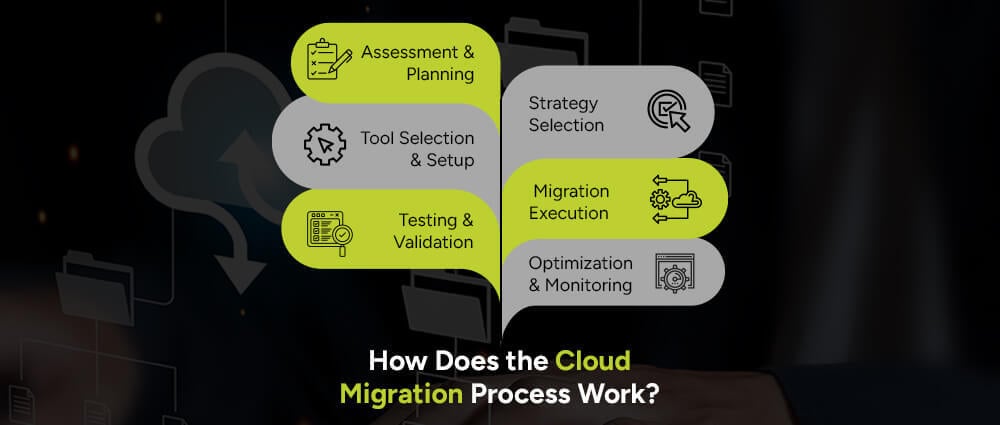
Moving to the cloud is not merely a tech trend but a strategic decision that aids businesses in becoming agile, scalable, and efficient with cost. But how does one undergo this transition? And where should one even start?
Before even conceiving the idea of migrating, look closely at your existing IT configuration. What applications do you use every day? What sort of data are you storing, and where? Do you want HIPAA compliant cloud storage for healthcare cloud migration, or other compliance storage for other industries?
It is all about understanding the demands of your business and determining what systems are ready to go into the cloud. This is an excellent time for you to identify risks and dependencies. In other words, know what you have available before trying to figure out where you’re going.
Not all cloud migrations are created equal. Depending on your goals, you’ll need to choose the right approach.
Each option has its pros and cons, so think about what’s best for your business in terms of time, cost, and long-term value, and then think about website migration to the cloud.
You don’t have to do everything manually, thankfully! There are many cloud migration tools that can simplify the process.
Some help with data transfer, others with security or performance optimization. Choose tools that match your migration strategy and set them up properly to minimize disruptions.
Now comes the actual move. But don’t start with your most critical systems, dip your toes in first. Migrate less important data or applications as a test run.
This way, you can catch and fix issues before they affect your business. Once confident, continue migrating more essential workloads in phases.
After each stage of the migration, test everything. Are your apps working as they should? Is the data intact? Can your team access what they need without hiccups?
This is your quality control checkpoint. Fix any bugs or gaps before declaring the migration a success.
Migration isn’t the finish line; it’s just the beginning. Once you’re fully in the cloud, you’ll need to keep an eye on performance, costs, and security.
Use cloud monitoring tools to track how everything is running, and adjust resources as needed to get the best bang for your buck.
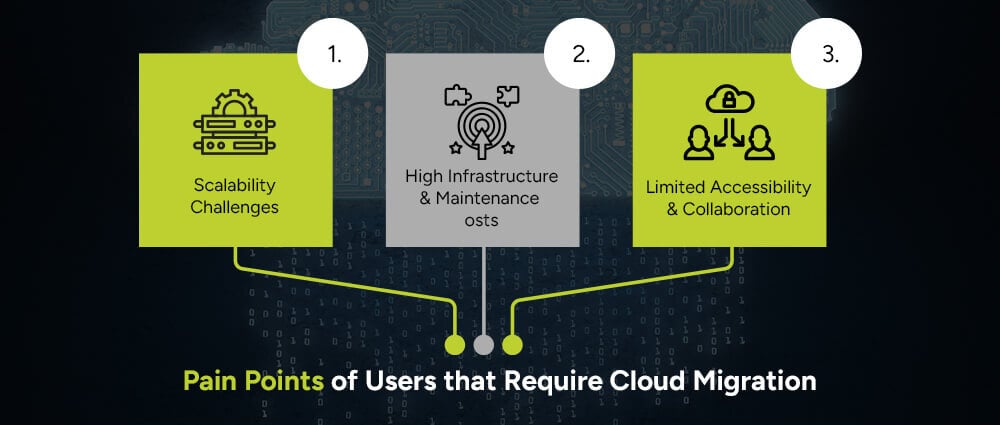
Many businesses start to feel stuck when their existing systems can’t keep up with growth. As more users, data, and apps come into play, their servers start to slow down or crash. This is where cloud migration makes a big difference.
The cloud gives you the flexibility to scale your resources up or down whenever needed, without having to buy new hardware or worry about physical space.
Running servers and maintaining them is expensive. Servers require the procurement of hardware, power, cooling, and IT staff. Moreover, regular maintenance is a requirement. On the contrary, over a certain period, all of this just accumulates in cost and eventually becomes hard to manage, especially for small to mid-sized businesses.
The cloud brings the costs way down. You pay only for what you consume, and extravagant investments in infrastructure are not needed.
With traditional systems, accessing files or tools remotely can be tricky or even impossible. This slows down remote teams and makes collaboration a hassle. The cloud solves this by making your data and apps accessible from anywhere, anytime.
All your teams need is an internet connection, which means better collaboration and more flexibility for everyone.
When moving to the cloud, not all applications and systems need the same approach. Depending on your goals, budget, and how modern your current tech is, you can choose from one or more of these 7 cloud migration strategies:
This is the simplest and fastest option. You just take your existing applications and move them to the cloud without making any changes.
It’s like moving your furniture to a new house without redecorating. Its good for quick migrations and legacy systems.
Here, you move the app to the cloud but make a few tweaks to take advantage of cloud features, like changing the database or upgrading the OS.
You’re still not redesigning the app, just making it cloud-friendlier. You can take advantage of this for apps that need minor improvements.
This means replacing your current app with a new, cloud-based version, often a SaaS solution.
Think of switching from a self-hosted CRM to something like Salesforce. It’s mainly used for standard business apps like CRM, HR, and email.
Refactoring in Cloud Migration means completely redesigning the application to take full advantage of cloud-native features like microservices, auto-scaling, and serverless computing.
It’s more work, but the long-term gains in performance and flexibility are big. Its good for apps with scalability and performance issues. You can watch out for higher costs and longer timelines with this one, though.
Sometimes, you’ll find apps or systems that are no longer needed. Retiring them can save money and reduce complexity.
Before moving everything, take stock and ask yourself if you still need this? It is good for old, unused, or redundant systems.
Some apps might be better off staying where they are, for now. Maybe due to regulatory reasons, performance, or because they’re too complex to move.
In these cases, you retain them on-premise while planning for future migration. Its suitable for critical or complex legacy apps.
This is about moving your entire infrastructure or platform, like VMware, to the cloud without changing any of the apps running on it.
It’s kind of like lifting your whole data center and placing it inside a cloud provider’s environment. This cloud strategy is ideal for bulk moves of virtualized environments
Each of these cloud migration strategies serves a specific purpose, and it’s common to use a mix of them depending on your app portfolio. A thoughtful cloud migration plan and a clear understanding of your goals will help you choose the right combination.
Cloud migration isn’t always smooth sailing. Some of the most common challenges include:
The big question always is: given that it is sensitive data, is it safe to move to the cloud?
One of the biggest fears a company can have is that there might be a data-in-transit issue, data leak, or unauthorized access, or any compliance violation.
Hence security should be there very first in your cloud migration plan: security by encryption, security by access control, and security by audit.
Downtime During Migration
No one wants a black hour with the website or app labelled under construction. But if your migration is not well planned, the under-construction hours might well gain some extra value there.
That means customers can’t access your services, and internal teams might be stuck waiting. A good migration plan minimizes this with step-by-step transitions, good cloud backup services and systems, and lots of testing.
Compatibility Issues with Older Apps
Some older applications don’t play well with the cloud. Maybe, its because they rely on outdated tech, or they weren’t built with cloud in mind. In these cases, you’ll need to either update/ refactor the app or keep it on-premise for now.
Either way, it’s a challenge that needs careful attention, otherwise, you risk breaking critical business tools.
Lack of In-House Cloud Expertise
Cloud technology can be complicated, and most companies have no internal expertise to manage it.
Your very own IT department may perform excellently at on-premise systems, but lack the know-how and experience to manage cloud platforms, security policies, and troubleshoot cloud-native issues.
In such scenarios, it is quite often best to engage a qualified cloud services company for assistance.
Unexpected Costs
After initial costing, most companies start questioning their high costs. Many companies go into cloud migration thinking it’ll save money, which it usually does, but poor planning and over-provisioned resources can quickly rack up surprise costs.
Ongoing monitoring and cloud cost optimization are key to keeping things in check. What we are trying to say is that while the benefits of cloud migration are huge, being aware of these challenges and planning ahead can save you a lot of money.
There are plenty of providers out there, but the best IT services company for cloud migration services and cloud consulting are the ones that understands your business needs, has a proven track record, offers tailored solutions, and supports you before, during, and after the migration.
Look for companies that also help with cloud cost optimization, security, compliance, and ongoing support.
After earning about cloud cryptography and migration, here’s why so many businesses are making the move:
These advantages of cloud migration can give your business a serious competitive edge.
Cloud migration is part of a bigger picture known as cloud transformation. Here are the general phases:
Each phase brings more value to your business.
Cloud migration isn’t just a tech upgrade, it’s a smart move for businesses that want to grow, innovate, and stay competitive. With the right cloud migration company and strategy, tools, and support, the journey becomes smoother and more rewarding.
Ready to take the leap? Let Arpatech’s cloud services work for you, securely, efficiently, and affordably.
The cost of cloud migration depends on the size of your business, the amount of data being moved, your cloud provider, and whether you need to refactor applications. On average, small to mid-sized businesses may spend anywhere from $5,000 to $100,000. But remember, it’s an investment that pays off in efficiency, security, and innovation.
There are seven common approaches in all clouds from multi cloud to hybrid cloud (also called the “7 Rs”):
Once your migration is complete, the real work begins. You’ll monitor performance, adjust resources, manage security, and optimize your cloud setup. You’ll also have the flexibility to build new services and scale as your business grows.
Ongoing optimization is the biggest challenge. After moving to the cloud, businesses often struggle to manage costs, monitor performance, and keep security tight. This is why continuous management and expert support are essential.
Ramsha Khan
Jul 10, 2025

07 Cloud Backup Services for SMEs
Running a small or medium-sized business (SMB) today means juggling a million tasks at once, and securing your data should be one of the top priorities. That’s where cloud backup services come in. They’re not just for big corporations anymore. With affordable, flexible plans and user-friendly tools, cloud backup services are now a smart choice for SMEs too.
But what exactly are these services, and how can they help your business?
Let’s begin with some elementary knowledge: What are cloud backup services?
Simply stated, they store data “off-site,” remotely on secure servers, most of them managed by some third-party vendor. In this case, in the event of a laptop crash or server failures, your data is safely kept in the cloud.
Gone are the days when you would rely on antiquated USB drives or local backups. Cloud storage will give you reassurance knowing your business data is always protected and recoverable. And that is just one of the many advantages that cloud backup services offer, with security, convenience, and accessibility being the more obvious reasons.
While some solutions may be tailored for different SME needs, they really offer enterprise-class cloud backup services. So, one may ask, what is the role of cloud-managed services? Enterprise cloud backup services have the following outstanding features:
These features make modern cloud backup services suitable for businesses that need flexible, secure, and scalable storage options.
In other words, cloud storage is an investment when it comes to cloud infrastructure management, and such effective planning, where one could maximize the benefits of buying space in the cloud, would include the gravity of backup services. It is worth the significant difference it makes in backing up one’s data and recovering it whenever needed. Well, let’s break it down:
This process is what we mean by implementation of cloud backup strategies, a structured approach to using your backup solution effectively and consistently.
So, why are more SMEs are ready to migrate to cloud architecture and investing in the cloud? The advantages of cloud backup services go beyond just convenience:
In short, the benefits of cloud backup services make them a no-brainer for SMEs that value their data.
Despite the many perks, it’s important to be aware of the challenges of cloud backup services:
Understanding these risks helps you prepare better and choose smarter.
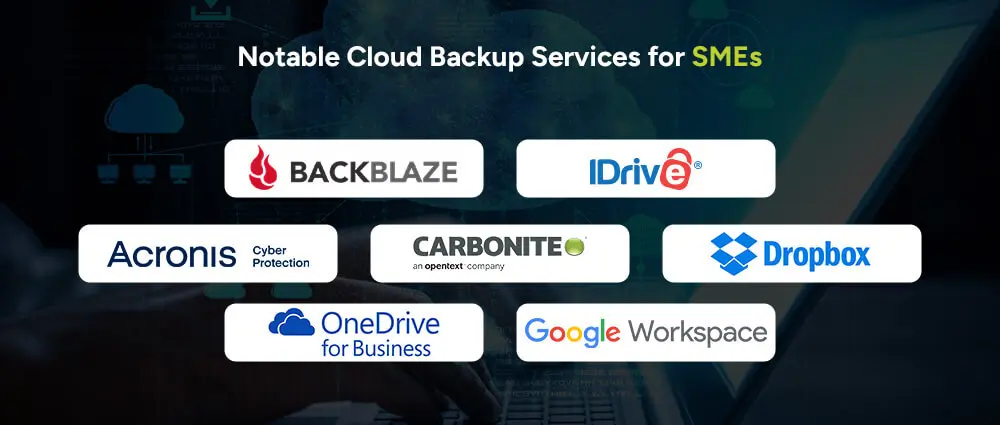
Now let’s look at seven notable cloud backup services used by SMEs around the world:
An easy-to-use service, Backblaze has a single low monthly fee for unlimited cloud storage for one computer. Backblaze is a great option for small companies that value stress-free backups without any hidden charges.
IDrive allows you to not only backup data into the cloud but also onto your local device. Hence, you get double protection for your files. This tool is best for businesses that desire an excellent backup proposal with added security.
Acronis not only works with backups but also protects from cybersecurity threats like malware and ransomware. Perfect for SMEs that want data backup and solid security capabilities.
Easy to set up with automatic and uninterrupted backups are the hallmark of Carbonite so that your files keep being saved regularly without you ever having to remember anything. Perfect for teams with little tech savvy.
This application works on the familiar Dropbox platform and saves multiple versions of your files automatically and in the background. Great for groups already using Dropbox for team collaboration.
OneDrive works seamlessly on Microsoft 365 apps such as Word and Excel, thereby making storing and accessing work documents quite easy. It’s a smart pick for companies already using Microsoft tools and require HIPAA Compliant Cloud Storage.
Google Workspace Backup (via Spanning):
This service backs up Gmail, Google Drive, Calendar, and Docs, so your Google Workspace data stays safe. It’s especially useful for SMEs that run daily operations through Google apps.
Each service brings its own unique value depending on your storage needs, team size, and risk tolerance.
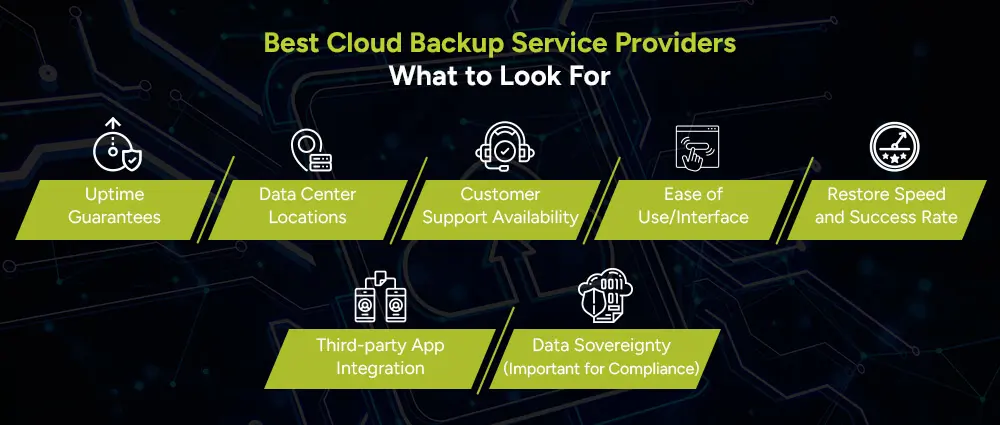
Whether youre going for Public Cloud vs Private Cloud vs Hybrid Cloud, If you’re based in the UAE or the surrounding region, these best cloud backup service providers offer localized expertise and globally competitive solutions:
An innovation-based tech firm delivering secure, scalable cloud backup services customized for SMEs. Their solutions include website migration to cloud, automated backups, storage management, and disaster recovery support.
Known for innovation and user-focused design, Tekrevol provides cloud-based backup solutions that scale with your business, along with cybersecurity and cloud consulting services.
A global IT powerhouse that also offers SME-friendly data backup solutions, including regulatory-compliant storage, business continuity, and cloud migration services.
As one of the oldest IT firms, Systems Limited provides trusted enterprise cloud backup services to small and mid-size businesses, including storage configuration, hybrid backups, and full disaster recovery tools.
These firms are great choices for SMEs looking for trustworthy and scalable solutions.
When choosing among the best cloud backup service providers or cloud consulting companies, always consider:
Look for providers that promise 99.9% or higher uptime to ensure your data is always accessible.
Choose a provider with data centers close to your region for faster access and better compliance with local laws.
Reliable 24/7 support is essential in case you face issues or need urgent help with your backups.
A simple and user-friendly dashboard makes it easier to manage backups without technical hassle.
Fast and reliable data recovery ensures your business can bounce back quickly after data loss.
Make sure the service connects smoothly with tools like Microsoft 365, Google Workspace, or Slack.
Ensure your data is stored according to your country’s privacy laws and compliance requirements.
Choosing the right provider means looking beyond price and focusing on value, security, and usability.
For SMEs, cloud backup services are no longer optional; they’re essential. Whether you’re running a small team or scaling fast, having a proper backup strategy is key to business continuity, especially in today’s hybrid work environment.
Understanding what cloud backup services are, their key features, and how to implement cloud backup strategies with backup services will empower your business to grow securely and confidently.
With options like Arpatech, the Middle Eastern SME sector has access to world-class solutions customized to all local and international requirements.
The time to protect your data is now, because once it’s gone, it may be gone forever.
Your cryptography It depends on your business needs. For SMEs, the best global tools are Google Drive and Dropbox Business. For the provider, you can contact Arpatech as the cloud backup service provider.
There is cloud cost optimization, but prices vary. Google Drive offers 1TB for around $10/month. Business-focused platforms may charge more depending on features like security, support, and scalability.
Absolutely. Compared to the cost of losing customer data, project files, or financial records, cloud backups are a small investment for big peace of mind.
Yes! You can subscribe to services like Google One, iCloud, or business providers like Dropbox, or even set up a private cloud if you have the technical know-how.
Ramsha Khan
Jul 8, 2025

Smart Finance and accounting BPO services for Growing S...
Managing finances can be tough, especially for small and medium-sized businesses (SMBs) where resources are limited, and every decision can have a big impact. Whether you’re just starting out or looking to streamline your growing operations, getting your finances in order is crucial. That’s where finance and accounting BPO services come in.
But what does that really mean? Let’s break it down in simple terms and explore how outsourcing your financial processes can help you grow smarter.
Think of Business Process Outsourcing (BPO) for accounting as: a helping hand with your finances. Rather than hiring and managing a complete accounting team in-house, you simply engage a trusted partner to handle the numbers on your behalf.
Anything from regular bookkeeping, payroll management, financial reporting, or tax preparation, these professionals are equipped with the tools and expertise to do everything. The best part? You would rather spend time growing your business than handling spreadsheets.
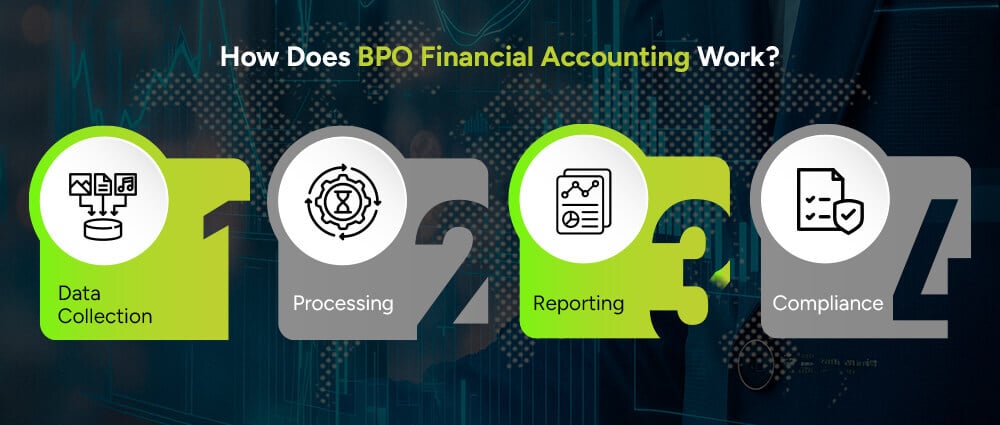
The finance and BPO accounting process typically starts with an assessment of your current setup. The service provider will look at your existing tools, reporting needs, and financial workflow. Then, they’ll create a customized plan to manage these tasks efficiently.
Here’s a breakdown of how this process typically works:
This is the foundation of the process. All financial actions need to be accounted for accurately hence, the BPO partner begins their work by collecting your financial papers. These will typically include invoices, receipts, sales figures, payroll, expense reports, and bank statements.
Most of the time, this process is automated through secure, cloud-based systems, thereby reducing manual errors and speeding up the collection. Contemporary finance and accounting BPO services have also started embracing your existing tools such as QuickBooks, Xero, or ERP systems so that you do not need to make a transformation on your current setup.
The next step after gathering data is organization and analysis. Applying sophisticated finance and accounting applications, a BPO specialist analyzes your financial information into structured formats. That means updating ledgers, classifying expenditures, controlling account payables and receivables, and reconciling.
Automation plays a key role here, with many leading finance and accounting BPO services utilizing AI-enabled tools for anomaly detection and trend identification to boost efficiency and accuracy.
Now that your data is clean and well-organized, the BPO team’s next job is to generate reports that give you real-time visibility into your finances. These can range from simple cash flow summaries to detailed profit and loss statements, balance sheets, budget vs. actuals, and forecasting models, enabling you to ultimately get a better revenue cycle management.
These reports are crucial for making informed decisions about spending, investing, and scaling your operations.
Compliance must be taken on strict priority. The gravest advantage of finance and accounts BPO services is being supported by professionals conversant with local laws as well as international ones in regard to finances.
From tax returns to audits, it is ensured that the records are compliant under the law. Every possible chance of being penalized, missing deadlines, or being subject to audits is considerably lessened. In some industries, like e-commerce and healthcare outsourcing services, it is a matter of the implementation of certain financial reporting standards; your BPO provider will assure that the standards are implemented to the letter.
So, how does BPO financial accounting work? It works by creating a smart, no-hands system that handles your day-to-day accounting needs while keeping everything clean, compliant, and ready for growth.
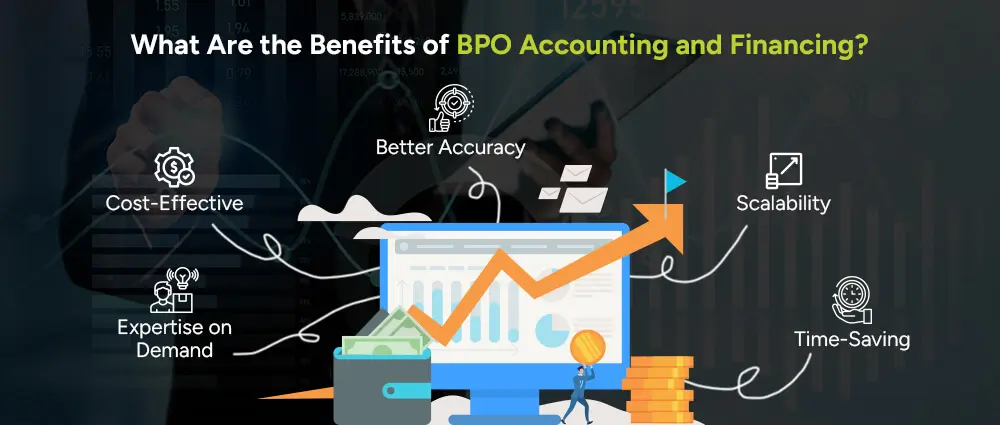
For small and medium-sized businesses, partnering with a BPO provider offers more than just convenience, it delivers strategic BPO advantages that can help transform your business. Let’s dive deeper into the benefits of BPO accounting and financing and why it’s such a valuable move.
Hiring, training, and maintaining an in-house finance team can put a strain on your budget, especially when you’re a growing business. With IT outsourcing price models and finance and accounting BPO services, you pay for exactly what you need.
There’s no overhead cost for office space, software licenses, or employee benefits. You can scale up or down based on your business cycles, making it a far more flexible and affordable option. In short, you get expert service without the expense of a full-time team.
One of the major challenges for any SMB is finding seasoned finance professionals. BPO already has accountants, analysts, and compliance experts entrenched in the business. They are industry-trained and exposed to the most sophisticated finance and accounting tools, so they can adapt very quickly to your specific needs.
From processing payroll to tax compliance and complex financial forecasting, you will have access to the right people with the right experience, but without a long hiring process.
Human error is one of the leading causes of financial discrepancies in small businesses. By outsourcing, you’re relying on teams that follow strict quality control procedures and use modern automation to reduce manual entry.
The finance and accounting business process integration includes checks and balances at every stage to ensure data accuracy. This leads to better decision-making and fewer issues during tax season or audits.
As your business grows, so do your financial needs. A small team that was managing well when you had 10 clients may become overwhelmed when you reach 100. BPO services are designed to grow with you. Need more frequent reporting?
Complex multi-currency accounting? Support for a new office? Your provider can adjust the service without you having to hire and train more people. This kind of built-in scalability gives you the flexibility to grow without financial bottlenecks.
Time-consuming money management leaves no space for multi-operational roles a business owner must often juggle. Gaining time again through even data entry outsourcing services to a trusted partner allows much more focus toward innovation, strategy, and customer relationships.
Now you can have a clear advantage from finance and accounting back office services, which is the fact that you are not stressing over tax deadlines or being buried under a stack of spreadsheets anymore. You’re working on your business, not in it.
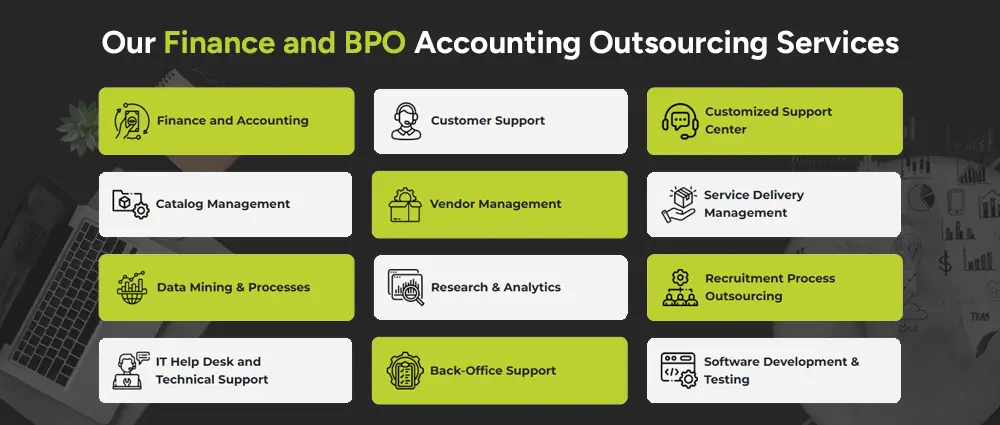
We offer some of the best finance and accounting BPO services tailored for small and medium businesses. Whether you need help with bookkeeping, financial planning, or tax compliance, our team is here to handle the numbers while you focus on building your business.
Our services include:
All of this is powered by the latest finance and accounting tools, ensuring speed, security, and accuracy.
Outsourcing your finance tasks to professionals offers a clear advantage for finance and accounting back office services. You get a dedicated team without the overhead costs of hiring and training.
Plus, you get peace of mind knowing your finances are handled by experts who follow industry best practices and compliance standards.
Outsourcing your financial operations doesn’t mean giving up control, it means gaining the support you need to manage your business better. With the right finance and accounting BPO services at Arpatech, small and medium-sized businesses can improve accuracy, save money, and grow with confidence.
For a free consultation, contact the experts today!
A financial accountant in BPO deals with different activities regarding the finances of a company. Activities like data entry outsourcing, keeping financial records, preparing reports, reconciling accounts, processing payroll, and adhering to compliance regulations. They act as a virtual finance department for your business.
The cost depends on the size of your business, the complexity of your financial needs, and the services you require. Typically, BPO services are more affordable than hiring a full in-house team. Most providers offer flexible pricing models, either fixed monthly fees or pay-as-you-go options, depending on what fits your business best.
Ramsha Khan
Jun 26, 2025

Data Entry Outsourcing Services for SMEs
Running a small or medium-sized enterprise (SME) means juggling a lot, sales, operations, customer service, and yes, data management. If you’ve ever found yourself buried in spreadsheets or manually entering information when you could be growing your business, then it might be time to consider data entry outsourcing services.
Let’s break it down in a simple, conversational way.
Some people might argue that data entry work can be repetitive, rather time-consuming, and even considered a mundane task for any business. Still, it is, in fact, an essential aspect of the business. Accurate records from data entry can help in everything from customer service to compliance.
That is the place where outsourcing data entry services comes into play. Instead of hiring and managing in-house staff, the task can be delegated to data entry professionals with flair for speed and accuracy.
When you think of data entry outsourcing services, it’s easy to imagine someone typing away at a computer. But there’s more to it than that. Did you know there are two main types of data entry services?
Depending on how your data is collected and used, your business may need online or offline data entry services, or a mix of both.
Let’s break them down:
These are tasks that require a constant internet connection. Think of it as real-time data processing, usually done directly into cloud-based platforms or web portals.
This is ideal for businesses with fast-moving operations or those using digital workflows, like e-commerce sales using Shopify or BigCommerce. When you choose top data entry services for outsourcing, online services help keep everything flowing smoothly without disruption.
Offline data entry business process integration is done without an active internet connection. The data is first collected and then entered into software or documents locally before being uploaded or transferred.
Businesses in healthcare, legal, and insurance often rely on offline data entry services, especially when privacy and compliance are a priority, such as with medical data entry outsourcing services.
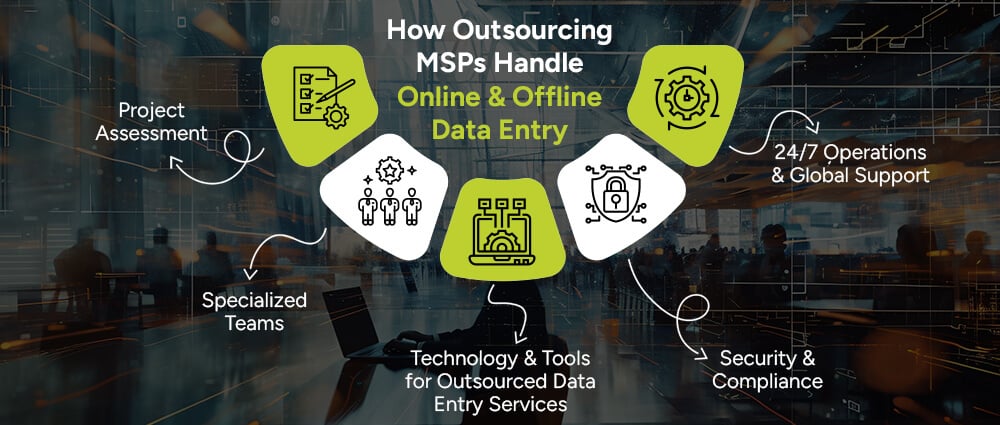
Managed Service Providers (MSPs) play a key role in delivering high-quality data entry outsourcing services. Here’s how they manage both types effectively:
MSPs start by understanding your business needs, what type of data you handle, how it’s collected, and what your turnaround times are. They then recommend a mix of online and offline data entry services based on efficiency, accuracy, and cost.
MSPs have trained professionals skilled in both areas. For online tasks, they use secure cloud-based tools. For offline work, they rely on local systems and strict quality control to ensure accuracy before any data goes live.
They leverage automation, OCR (Optical Character Recognition), data validation software, and secure file transfer protocols to ensure quick and reliable results, whether your data is coming in real-time or in bulk batches.
These managed service providers (MSPs) are home to extremely high standards in the area of data security, considering middle-term segments like finances and healthcare. Most of them are even HIPAA-, GDPR-, or ISO-compliant-certified. All the more important in the outsourcing of medical data entry services.
When it comes to data entry, whether in an office or around the clock, MSPs usually span multiple time zones. Faster results even on impromptu projects as there is no reluctance to go onsite at any time to collect data.
If you are a small or medium enterprise owner or manager, you will realize that the speed at which administrative work runs into the workflow-fast data entry has taken a lot of time out of your team. That is why, for a smart business move, outsourcing is not just about convenience. So, let’s discuss further why a small-to-medium business is turning data entry outsourcing.
Hiring full-time employees for data entry might sound like a good idea, until you calculate the true cost. Salaries, benefits, workspace, training, software licenses…it adds up fast.
With IT outsourcing price models data entry services, you only pay for what you need. No overheads, no infrastructure investment. You get access to the same high-quality results at a fraction of the cost. That’s why SMEs look for the best value data entry outsourcing services, to stay lean while staying ahead.
Let’s be real, data entry isn’t what drives growth. But it is what keeps your business organized. It is part of the revenue cycle management.
When you hand over the repetitive work to a data entry outsourcing services company, your internal team can focus on what they do best, serving customers, closing deals, improving operations, and innovating. It’s all about using your resources wisely. Let the pros handle the data; you focus on the bigger picture.
Accuracy is everything when it comes to data. A tiny typo in an address, invoice, or customer record can cause major confusion.
With top data entry services for outsourcing, you gain access to trained professionals who live and breathe accuracy. Whether it’s medical data entry outsourcing services that require strict compliance, or standard business data, these experts are familiar with industry best practices and tools that make data clean, consistent, and useful.
Got a busy season coming up? Running a big marketing campaign? Expanding into new markets? That usually means a flood of new data.
The beauty of data-entry outsourcing services industry is that it’s built to scale. Need a small team today and a bigger one next month? No problem. BPO advantages give you the flexibility to ramp up or down without the stress of hiring or firing. It adapts to your business cycle, effortlessly.
By outsourcing, you’re not just reducing the workload, you’re upgrading your workflow. From online data entry services to offline data entry services, there’s a solution that fits every SME. It’s efficient, reliable, and smart business all the way.
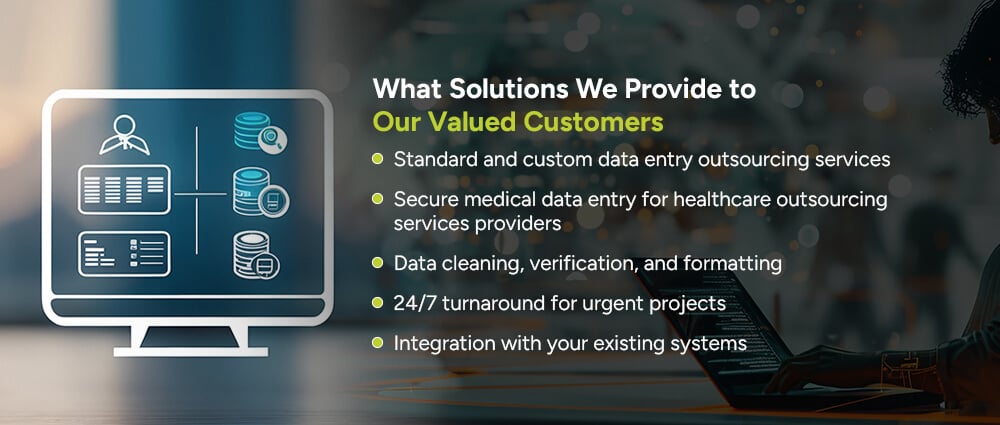
When it comes to top data entry services for outsourcing, we pride ourselves on offering tailor-made solutions. Here’s what we offer:
We understand that every SME is unique, which is why our services are flexible, scalable, and designed for best value data entry outsourcing services.
Outsourcing data entry isn’t just a smart move, it’s a strategic one. With top data entry services for outsourcing, SMEs can cut costs, improve accuracy, and focus on what truly matters: growing the business. Whether you need online data entry services, offline data entry services, or specialized medical data entry outsourcing services, the right data entry outsourcing services company, like Arpatech, can make all the difference.
Ready to take the first step? Let’s talk about how we can help your business thrive with reliable and professional data entry outsourcing services.
Costs can vary depending on the volume and complexity of the data. We offer packages that give the best value data entry outsourcing services for SMEs.
Yes! Some key trends include the use of AI for error detection, automation of repetitive tasks, and increased demand for medical data entry outsourcing services due to healthcare digitization.
Meta Title: Why SMEs Should Outsource Data Entry: Improve Business Success
Meta Description: Discover how small and medium-sized enterprises SMEs are able to streamline operations, reduce costs, and improve accuracy by outsourcing data entry tasks.
Ramsha Khan
Jun 24, 2025

How Do Remote Managed IT Services Work?
Picture this: your team is working in harmony like every day, your systems are running smoothly with glitches, and then…
Suddenly, something breaks. A server crashes, emails stop working, or a strange virus appears out of nowhere!
Now imagine if someone could swoop in, fix the issue before you even notice it, and do it all without setting foot in your office.
That’s the hand of remote managed IT services.
These services offer behind-the-scenes IT support, maintenance, and security, all handled from a distance. Whether you’re running a small business or scaling fast, remote IT managed services keep your tech running smoothly, securely, and without disruption.
Remote managed IT services provide the advantage of having an IT department right at the home premises. The cost of hiring a full-fledged in-house team is exorbitant, so, it is better to hire a third-party service provider that remotely tracks, maintains, and manages the entire technology infrastructure for the company. This can include everything, from updating your software to network security, troubleshooting hardware problems, and managing cloud systems.
Such services are offered over the internet. The tools and techniques employ remote monitoring and management (RMM) for your devices, networks, and systems without the presence of someone physically in your office.
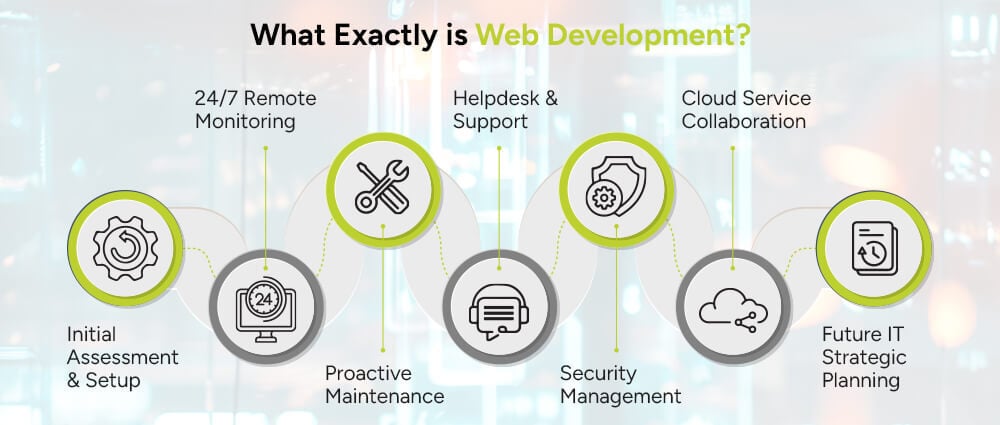
Let’s walk through how managed IT services remote work in real life:
Before anything, the provider you connect with begins by assessing your current IT environment, checking hardware, software, network setup, security vulnerabilities, and conducting a thorough assessment of the entire infrastructure. They identify all missing pieces, the security gaps, vulnerabilities, and the performance bottlenecks. Based on that, they tailor a service plan for your needs. The entire MSP onboarding process includes:
Once the systems are set up, the provider uses remote monitoring and management tools to watch over your network, servers, and endpoints. These tools detect issues like low disk space, failing hardware, or unusual network activity, often before they cause real problems.
This is called managed IT services remote monitoring and management, a key backbone of the whole process.
Regular updates, security patches, backups, and performance tuning are all handled remotely. The goal is to prevent issues before they happen, not just react to them.
When employees run into tech problems, they can contact the provider’s helpdesk for fast, remote assistance. From forgotten passwords to application crashes, the support team is just a call or ticket away.
Your remote IT team also handles antivirus updates, firewall monitoring, data encryption, and threat detection. Today, cybersecurity is a huge part of remote co-managed IT services, especially for businesses with sensitive data like Medical practice IT support.
Companies that rely on applications on the cloud, like Google Workspace, Salesforce, and Microsoft 365, your Managed IT service provider enables maintenance and integration by:
One big advantage of working with a remote managed IT services company is their proactive approach. Instead of just fixing problems, they help plan your long-term tech strategy to keep your systems up-to-date, efficient, and aligned with your business goals
To better understand how all of this works, here are some essential parts of a typical remote IT setup:
This tool keeps an eye on your computers, servers, and networks from afar.
It helps spot issues early, often before you even notice something’s wrong.
Your important files and data are saved regularly in case something goes wrong.
If there’s a crash or cyberattack, everything can be quickly restored.
Software updates and security fixes are installed automatically.
This keeps your systems safe from hackers and running smoothly.
Helps control and organize tools like Microsoft 365, Google Workspace, or cloud servers.
It makes sure everything in the cloud is secure, efficient, and easy to access.
Cubersecurity solutions includes antivirus, firewalls, and tools that protect your devices and data.
These tools guard against viruses, hacking, and other online threats.
A remote team you can contact for quick tech support.
They solve problems, answer questions, and keep your systems running.
You get regular updates showing how your IT systems are doing.
These reports help you understand performance, spot risks, and plan ahead.
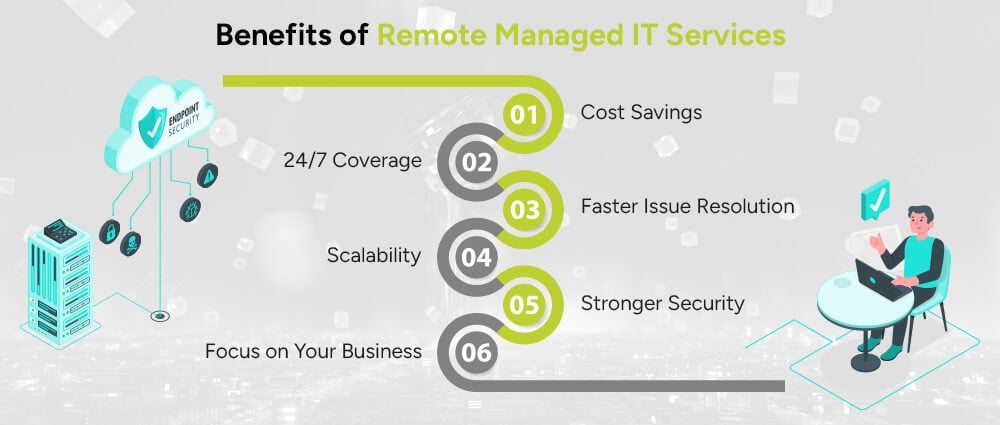
So, why are more businesses turning to managed IT services remote solutions? Lets see the advantages that we get with remote IT services:
There is no need to hire or maintain a full in-house IT team, thereby incurring extra salaries, training, or office-space requirements. Remote providers offer flexible pricing models that let you pay for the services you actually use. Thus, remote IT support is an affordable and scalable solution, most suitable for small to mid-sized businesses.
Continual remote monitoring ensures that your systems are watched every hour, every day, including weekends and holidays as well as outside business hours for any anomalies or threats typically identified before they can cause real disruptions. This is because a high level of availability guarantees that performance remains uniform and possible unplanned downtimes are significantly reduced.
Remote managed IT services use monitoring tools to identify and address issues quickly, often without needing to step foot in your office. This remote approach allows for immediate troubleshooting, reducing downtime and maintaining productivity. Problems that would otherwise take hours or days to fix can be resolved within minutes.
As your business grows and your IT needs become more complex, remote IT services scale alongside you. Whether you’re onboarding new employees, expanding to new locations, or adopting new technologies, these services adjust easily. Remote co-managed IT services are particularly helpful in supporting internal teams during periods of rapid growth or transition.
Security isn’t a one-time setup; it requires continuous nurturing. Remote managed IT services offer a proactive threat-detection service, regular patching, firewall updates, anti-virus updates, and system monitoring that makes sure their clients with ongoing protection. Their aim is to obviate the potential security gaps before they transform into exploitative vulnerabilities or data breaches.
When someone else is handling your IT operations, you’re free to focus on what matters most, growing your business. You don’t have to get bogged down with technical issues, system errors, or compliance worries. With IT experts managing your infrastructure in the background, you can concentrate on strategy, innovation, and delivering value to your customers.
Remote managed IT services are like having an expert IT team without the overhead. They help businesses stay secure, efficient, and ready for growth, all from a distance. Whether you’re a small business or a growing enterprise, these services make sure your tech stays reliable while you stay focused on your goals.
Have questions about setting up your own managed IT services remote monitoring setup? Let’s talk with the IT help desk Experts at Arpatech, as we already know that the future of business IT is remote, and it’s smarter than ever.
Your business won’t stay the same size forever, and neither should your IT services. A scalable provider can:
Costs vary based on:
Ramsha Khan
Jun 19, 2025

Multi-Cloud vs Hybrid Cloud Solutions: What’s the...
The US cloud computing market is projected to grow up to 639.9342 billion by the year 2030. It has been a great turning point for businesses of all sizes. But with great power comes… well, a lot of options.
If you’ve been researching cloud strategies, you’ve probably stumbled across two terms that seem similar but are actually quite different: multi-cloud and hybrid cloud. So, what is multi-cloud vs hybrid cloud? Let’s break it down.
Multi-cloud can be loosely analogous to visiting different stores for different items, groceries from one, clothes from another, and the latest electronics from yet a different store. The multi-cloud concept refers to using two or more cloud services from different service providers at the same time, such as simultaneously using AWS, Microsoft Azure and Google Cloud Platform. The ultimate goal is to get workloads distributed across multiple vendors in order to avoid reliance on any single provider, reduces risk, or even choose services from each provider that best meet business requirements.
In short, multi-cloud refers to the use of multiple public cloud providers, which is typically done to avoid vendor lock-in, and it will also help in optimal performance and cost.
Now let’s say you have your own personal garden, which in this sense is your private cloud, but sometimes you also visit a local farmer’s market for seasonal fruits, which here is called the public cloud. That’s the essence of a hybrid cloud.
A hybrid cloud combines a private cloud, on-premises or hosted, with one or more public clouds, all working together. This setup lets data and applications move seamlessly between the two environments, which is great for flexibility and scalability.
In short, a hybrid cloud is a mix of private and public clouds, offers better data control and flexibility, and is ideal for companies with sensitive data that still want cloud scalability.
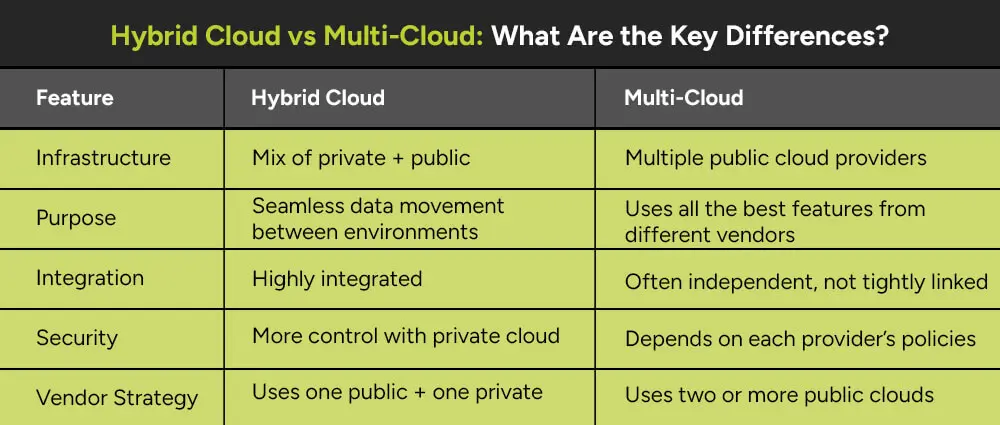
When it comes to cloud cryptography, both strategies involve multiple cloud environments, but they’re not the same. Let’s look at the hybrid cloud vs multi-cloud debate side-by-side:
| Feature | Hybrid Cloud | Multi-Cloud |
|---|---|---|
| Infrastructure | Mix of private + public | Multiple public cloud providers |
| Purpose | Seamless data movement between environments | Uses all the best features from different vendors |
| Integration | Highly integrated | Often independent, not tightly linked |
| Security | More control with private cloud | Depends on each provider’s policies |
| Vendor Strategy | Uses one public + one private | Uses two or more public clouds |
^ This could also be in image form or an infographic.
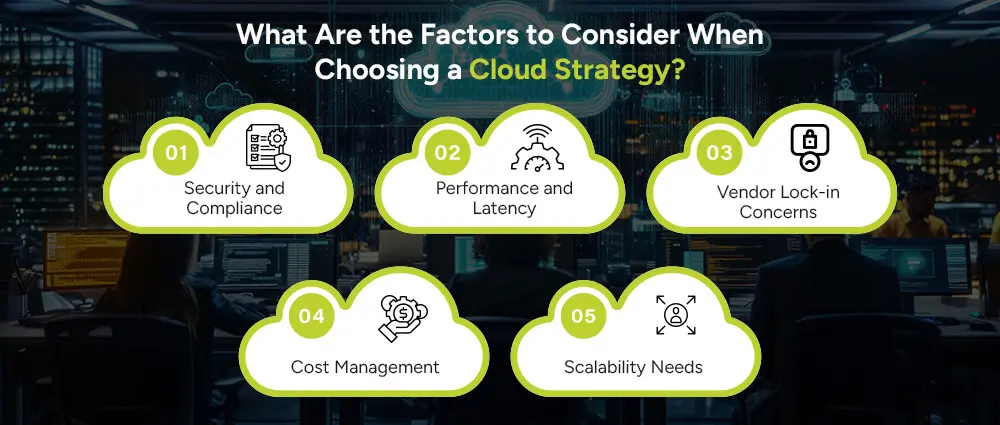
When managing multiple businesses and departments, it’s hard to decide what type of cloud and cloud infrastructure management should be employed to ensure business success. So, which one should you choose? That depends on a few factors, like:
Handling sensitive data like healthcare cloud migration or financial records? A hybrid cloud might be better due to the private cloud option.
Do you want to minimize lag? Multi-cloud can help place workloads closer to end users by leveraging different data center locations.
Many businesses work with many providers or consulting companies because they don’t want to depend on just one provider. Multi-cloud is your best bet here, multiple clouds, no loss of data ever!
Both can help manage costs, but multi-cloud may give you more pricing flexibility by playing vendors against each other.
If you’re expecting to scale quickly, hybrid cloud can offer a solid mix of on-demand public cloud resources with the consistency of private infrastructure.
The terms hybrid cloud and multi-cloud are sometimes interchangeable but they indicate different almost-alike methodologies for cloud computing: with the hybrid cloud, organization can combine an on-premises/private cloud setup with one or more public clouds affording flexibility and control over where and how data and workloads are handled, while multi-cloud indicates the use of more than one public cloud provider at the same time, often so that it can take advantage of strengths from each provider or to avoid being locked into a single vendor.
One of the most common example of a hybrid cloud is to manage data residency and compliance. For instance, healthcare or finance organizations might have to store information like patient records or customer data in a private cloud due to regulatory requirements, while using public clouds for processing other less sensitive data or running applications. Cloud bursting is another great hybrid scenario. For example, taking a retail enterprise that has the majority of its website traffic directed to the private servers but “bursts” that additional demand into the public cloud during busy shopping seasons, such as on Black Friday, to avoid bottlenecking.
Hybrid clouds will benefit organizations that are website migrating to the cloud in a staggered manner. Instead of migrating all applications and data at once, organizations can keep their core systems in their data centers and slowly migrate non-critical applications to the cloud as required. For larger organizations, this tends to be a more pragmatic approach. Additionally, some organizations use hybrid clouds in a disaster-recovery scenario to keep a backup copy of the most critical systems in the public cloud, ensuring the quickest possible recovery of operations should their private datacenter ever go down.
Multi-cloud comes in handy when organizations seek to shift their dependence from a monopolistic reliance on a single cloud vendor. For instance, an organization might use Amazon for HIPAA-compliant cloud storage, take Microsoft Azure for enterprise tools, and depend on Google Cloud for all of their machine learning capabilities. Such an organization is taking advantage of the superior services that each provider has to offer without limiting itself to just one vendor. Multi-cloud is at an advantage when an organization goes global, as such an organization may use different providers in different geographical locations, of course, to optimize performance or comply with local laws.
Another situation where multi-cloud is practical is after a merger or acquisition. If two companies each used different cloud providers before they came together, continuing to use multiple clouds might be more efficient than migrating everything to one platform. Overall, the role of cloud managed services, especially multi-cloud, gives companies flexibility and resilience by spreading their resources across different platforms, but it also requires strong management to keep everything working smoothly.
In short, hybrid cloud is often about integrating private and public environments to increase control and flexibility, while multi-cloud is about using several public cloud providers to stay agile and avoid limitations. Some organizations even combine both strategies, connecting a private cloud to multiple public ones, so they can get the best of both worlds.
If your hybrid cloud setup connects your on-premises environment (or private cloud) with more than one public cloud provider, then it is both a hybrid cloud and a multi-cloud.
Example:
This setup is:
Choosing between multi-cloud vs hybrid cloud isn’t just a superficial thing, it’s about your business goals, challenges, and future plans. Whether you want the control of a hybrid setup or the versatility of a multi-cloud environment, understanding the differences will help you make the right call when you’re thinking about going between public cloud vs private cloud vs hybrid cloud.
Also, if you end up using both? You’re in good company. Many businesses are going hybrid and multi-cloud to get the best of both worlds. Want to know which way to go? Leave us a message at Arpatech and let the experts take the reins on what direction you want your business to go.
Yes! A hybrid cloud can include multiple public clouds along with a private cloud. In that case, it’s both hybrid and multi-cloud, combining the best of both worlds.
The common features of hybrid and multi-cloud are:
The best cloud consulting companies will give you the reasons of hybrid and multi-cloud usage. Here are some:
Ramsha Khan
Jun 17, 2025

How to choose a cloud service provider for SMEs
If you’re running a small or medium-sized business (SME), you’re probably also getting ready to integrate cloud computing, and for good reason. The cloud isn’t just for big tech companies anymore. It has become an innovator in the smaller business industry as well, who are looking to grow without burning a hole in their budget.
But with so many options out there, it’s normal to ask: How to Choose a Cloud Service Provider? Let’s break it all down in a simple, conversational way.
A cloud service provider, commonly known as a cloud provider for short, is a company that offers services like cloud storage, computing power, and internet networking. Instead of buying expensive servers or software outright, you can effortlessly pay a subscription or usage-based fee to use their resources, enabling you to focus on the core areas of your business, whether its healthcare cloud migration, retail, or real estate, you can leave the IT infrastructure to the expert teams.
Amazon Web Services, or AWS, is perhaps the best-known of the big names in the cloud today. Then, of course, there is Microsoft Azure, along with Google Cloud, as the next-most-important players in the game. They are, however, not alone in this field; another host of providers with the benefits, prices, and services unique to them. All in all, to use those big providers, you still require a cloud service provider to take care of all your infrastructure needs properly.
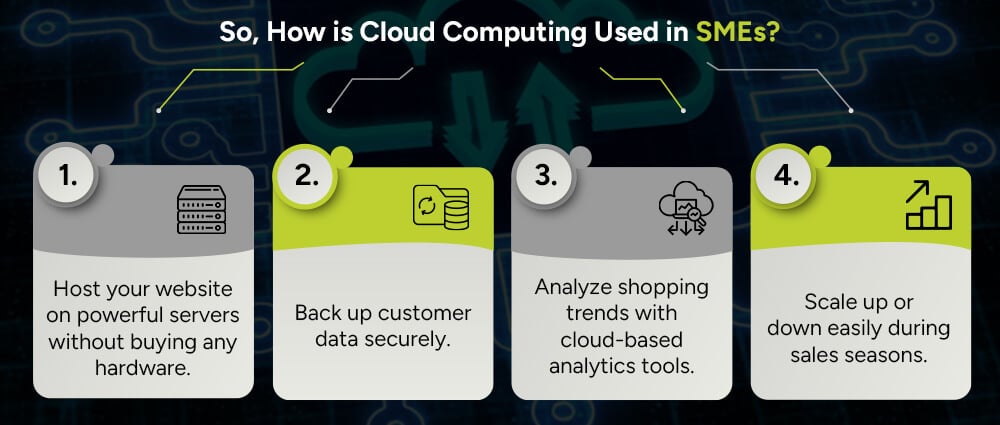
Let’s say you run an online clothing store. With the role of cloud managed services, you can:
From file sharing and storage to collaboration tools and data security, the cloud covers it all.
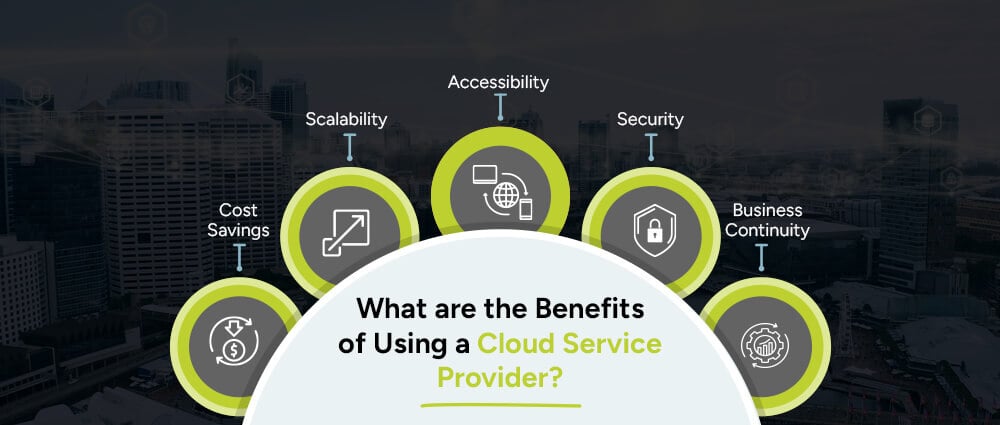
Some of the advantages that small and medium-sized businesses attain with the help of using a cloud service provider are as follows:
It’s a one-time investment. Once you get over that, you’ll gradually start to realize how you are saving costs in the long run. With no need for expensive hardware or IT staff, you are able to add more money towards your business and still have easy access to all of your data.
When you’re operating a small or medium-sized business, you never know when you’ll need to scale up or scale down. Cloud service providers offer you that extra bandwidth to help you meet your business demands and requirements almost instantly.
Start small and scale as you grow.
When your business is just starting out, you don’t always have an office to operate from, forcing you to manage your team remotely. With a cloud service, you have easy access to all your files in one location, and your teams don’t need to be in one place to search for files. All they need is a good internet connection, and they’re ready to work from anywhere at any time.
One of the best advantages of a cloud service is that you don’t have to worry about any kind of malicious activities or security breaches. Most cloud solutions meticulously monitor all activity using high-level encryption methods that ensure no unwanted accidents can ever occur.
One: Cloud platforms offer performance analytics that let you understand your consumer base better and identify all common patterns to help you improve. Two: cloud backups store all your information that you will require if you ever face disasters and need to recover quickly.
So, to summarize, cloud services help SMEs stay agile, secure, and competitive.
Now, let’s get to the main question: How to choose a cloud service provider? Here are a few things to consider:
Start by identifying what you actually need. Do you just need storage? Or do you want full-blown cloud infrastructure management for running applications? The clearer you are, the easier it’ll be to shortlist the right cloud service providers.
Now, look for the services offered and the service you require. Most providers offer a wide range of services that include the following:
In IaaS, physical or virtual servers, storage, and network infrastructure are rented. This allows companies to host their data and applications.
In this type of service, a platform is provided for developing and launching applications. This includes processing tools and data storage.
SaaS includes the utilization of software apps that are hosted by the service provider. These software applications can be accessed by users all over the world.
In FaaS, the cloud provider handles all server-side management, the developers build and run the applications as individual functions.
Now, align your requirements with the type of workload your providers offer and choose the best one for your business.
You want a provider that guarantees at least 99.9% uptime. Downtime means lost customers and revenue. Check their track record and service level agreements (SLAs). You need a service provider with a good record of uptime and reliability.
When picking a cloud service provider, go for one that has a solid setup and backup systems in place, as this helps avoid downtime. It’s also smart to check if they’ve had any outages in the past and how they dealt with them.
But uptime isn’t the only thing that matters. You should also think about how fast and well their services work overall. A trustworthy cloud provider keeps your data and apps ready and available whenever you need them.
Security poses grave challenges for many organizations, and therefore, choosing a cloud service provider that considers security as a primary factor is very important. It should employ robust security tools: data encryption, access control for secure operations, and regular security audits and tests. These features not only protect your data but also pose great opportunities in the field of cybersecurity, particularly for professionals on a global scale.
It’s also a good idea to choose a provider that follows industry rules and standards, like HIPAA compliant cloud storage or PCI DSS, depending on your field.
Plus, make sure you understand how the provider handles security incidents and data recovery, basically, what they’ll do if something goes wrong.
On top of that, cloud cryptography often offer asset tracking and protection through things like encryption, access limits, frequent backups, and monitoring for any suspicious activity.
When selecting a cloud service provider, scalability is one of the most important considerations since it allows increased or decreased use of any cloud resources as required by the organization at any point in time. This means that it can be called upon significantly when anticipating growth or if demand is likely to vary at any time during the year.
A good cloud consulting company should ease up overstretched budgets while adding new storage space, ramping up computing power, and turning them down when things slow down.
More importantly, however, is the fact that it saves costs since you only pay for what you actually use, freeing you from having a fixed setup that is not always going to fit your needs.
Tech issues happen. There must be a backup support team to turn to when running or storing important data in the cloud.
Check on the types of support offered by the provider like: full 24/7 support, multiple contacts like phone, email or even chat, etc. It always helps to check the reputation of a particular service regarding such things by checking reviews or ratings online. You will find all that soul-soothing peace of mind associated with opting for such great customer support when you choose a cloud provider.
With regard to pricing of services, cloud computing can bring you savings as compared to traditional IT setups. Before you sign a contract with any one provider, be sure to know all the details about pricing.
Some are very strict about pay-as-you-go pricing, meaning you pay only for what you use; others usually work out a fixed monthly price or a hybrid of the two. Make an effort to find price comparisons from different providers and see what is really included-support, maintenance, or some additional functions.
Check as well if long-term contracts are mandatory toward the provider or if there are possibilities for price adjustments in the future. By knowing all potential cloud cost optimizations in advance, you would be able to select a plan that matches your budget, thus avoiding any unwanted surprises later on.
Check whether your potential provider is able to seamlessly blend in-and-integrate with your current workflow, regardless of whether you’re using Microsoft 365, Slack, or QuickBooks. Think of how much retuning or reprogramming you need to correct in order to get your applications to work on this platform if your tools or technologies do not match.
Many providers provide useful migration services and help you plan the migration to cloud architecture well. Understand clearly exactly what sort of support these will offer and then compare that to your project needs. It helps you make the decision on who does what during website migration to Cloud. In some cases, their technical experts can step in to help fill any skill gaps on your team.
Of course, some of the bigger public cloud providers may not offer much in hands-on support. So, in those cases, you might need help from a good cloud integrating software company.
Here are a few top picks (with their standout features):
Choosing the right cloud provider doesn’t have to be intimidating. By knowing your business needs and asking the right questions, you can find a partner that grows with you.
Remember: How to pick a cloud service provider is less about finding the “best” one in general, and more about finding the best fit for your business.
If you’re still unsure, start small, test things out, and scale from there, and don’t hesitate to consult with Arpatech‘s finest cloud consultant to get your query solved in minutes and learn how to choose a Cloud Service provider.
Yes and no. Using multiple providers (called multi-cloud) can reduce risk and increase flexibility. But it also adds complexity. For SMEs, it’s usually best to start with one reliable provider and expand later if needed.
Ramsha Khan
Jun 12, 2025

Conducting Cybersecurity Risk Assessment in Large Organ...
Security threats in large organizations have been a big concern in recent years. Cybersecurity risks are no longer just an IT problem, they’re a business-wide issue. Large organizations have a lot to lose, whether it’s a data breach, ransomware attack, or internal misuse of sensitive information. That’s where a cybersecurity risk assessment comes into play.
So, let’s dive into what a cybersecurity risk assessment is, why it’s important, and how you can perform one effectively in a large organization.
Cybersecurity risk assessment refers to a method of identifying, evaluating, and prioritizing cyber threats and vulnerabilities that can adversely affect the organization and its information systems and operations.
Quite simply, it is an audit of all the doors and windows of a digital house. Organizations need to check if they are locked and identify the ones more prone to a burglar’s attention.
You might be thinking, Why go through the hassle? Here’s why:
A great example is seen in Cybersecurity Solutions for healthcare, where assessments help safeguard patient data and meet HIPAA standards.
When done right, a cybersecurity risk assessment offers major wins:
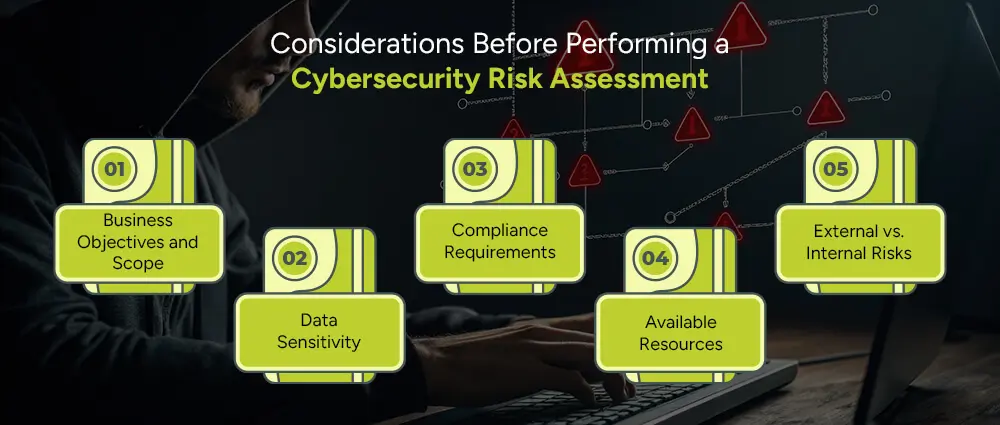
Before diving into a cybersecurity risk assessment, it’s important to pause and reflect on a few key things. This helps make sure your efforts are focused, effective, and aligned with your actual needs. Here are five important factors to think about:
Start by asking yourself: What are we trying to protect, and why?
Are you scanning the whole organization or just a particular part, like your finance department or customer service platform? A clear scope makes a great deal of difference. For example, if you wanted to protect customer data, your assessment would look something more like databases, CRM systems, and access control. However, if you intended to examine your entire business, your approach would have had to implicate a larger spectrum by department, from HR to IT. Think of it kind of like planning a road trip; You need to know your destination before you can even begin to map the route.
Not all data is created equal. Some information is much more sensitive than others, and understanding the different kinds of data that exist in your organization is critical to every risk assessment. This becomes even more critical when undertaking initiatives like Big Data Migration, where large volumes of data shift between environments.
Do you store customer credit card information? Employee medical records? or Confidential business strategies? The more sensitive the data, the more protection it needs. This will help you prioritize your security measures based on potential impact, what would hurt the most if it got into the wrong hands?
The regulations or standards that will be applicable to your business will depend heavily on the industry you’re in. These are not just things you need to live by; they are very much legal and operational must-haves. For instance, being in healthcare entails HIPAA compliances for patient health information. If you happen to be in finance, PCI-DSS may govern you in payment data or SOX in financial reporting. Any relevant regulations must be considered in a proper risk assessment to avoid facing fines or losing the trust of customers and stakeholders.
No organization can boast of having a bottomless well of money, time, or manpower. Therefore, it is strongly recommended that a realistic assessment of your reach be carried out.
Is this something that can be done internally, or will you need to outsource it? Do you have the right scanning tools for vulnerabilities or will you be investing in some? Some risk assessments are quick and high-level, while others are detailed and involve advanced technology. The resources you have available will therefore dictate which approach you follow.
Cyber threats may be from anywhere external or internal ones emanated by employee negligence, misuse of access, or even insider attacks: everything should be taking the same importance into consideration.
In fact, both should be taken into account in a comprehensive risk assessment. For example, do employees tend to use strong passwords? Access control is enabled so that unauthorized users cannot view sensitive information? Balancing internal and external threats creates a more holistic picture of your cybersecurity landscape.
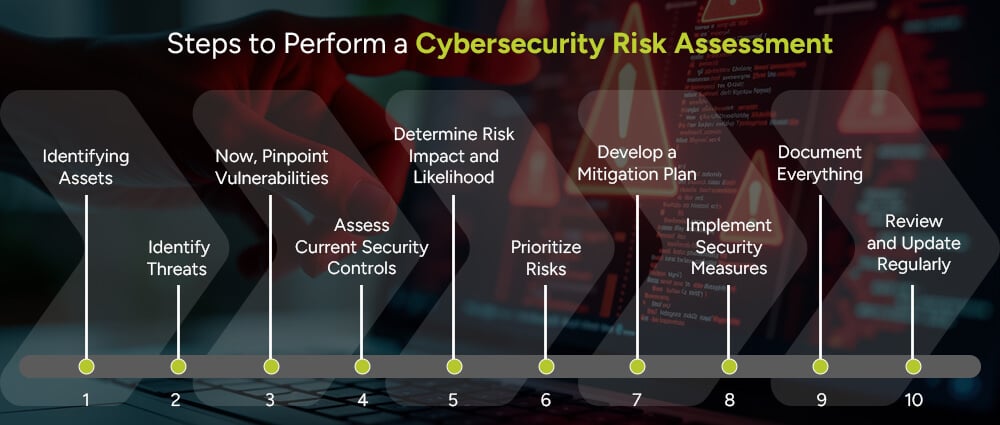
In large corporations, it is important that you know how to assess the environment of your system and see if your infrastructure is at risk. Here are a few simple steps that will help you identify, evaluate, and manage the threats to your digital systems:
Start by listing all your critical assets. This includes computers, servers, mobile devices, software applications, and sensitive data. Think about everything that plays a role in your day-to-day operations.
You can’t protect what you don’t know you have, so be thorough and organized here.
Next, ask yourself: What could go wrong? Threats can spring out of nowhere, could be anything from phishing emails and ransomware to natural disasters or insider mistakes. Don’t forget there’s always a risk of less obvious threats like stolen devices or social engineering.
One tip to follow in this scenario is to get creative, it will help you stay ahead of any malicious intrusions..
Now, look for weak points that make you more vulnerable to threats. This could entail outdated software, weak passwords, or a lack of employee security training.
Basically, any and everything that can be exploited by external factors needs to be on your radar.
Take stock of what protections you already have in place. firewalls, antivirus tools, access restrictions, etc.
Ask yourself: Are these controls working effectively? Are they up to date? Understanding what you’re already doing helps you see what gaps still need to be filled.
For each threat and vulnerability combo, think about how likely it is to happen and how bad the impact would be. Would it cause a minor inconvenience or bring your whole system down?
This helps you rank your risks from “nice to fix” to “must fix now.”
Now that you know the biggest risks, it’s time to prioritize. Start with those that are both highly likely and highly damaging. This way, you can use your time and resources where they matter most.
For each top-priority risk, create a step-by-step plan to reduce or eliminate it. This might include applying software patches, strengthening policies, getting a good cybersecurity patch management team, or rolling out staff training. Think practical, actionable, and tailored to your specific setup.
Put your mitigation strategies into action. Whether that’s configuring a firewall or training your team, execution is key. It is your duty to ensure that each action is tracked and completed thoroughly.
Keep detailed records of your risk assessment process, what you found, what you fixed, and what’s still pending. Documentation is essential for audits, compliance, and learning over time. It’s also helpful for onboarding new team members or when reviewing past issues.
Remember, Cyber threats aren’t a one-time thing. So, neither should your risk assessment be a once-in-a-lifetime thing. Set a schedule to review and refresh your process. Ideally, every 6 to 12 months or after major changes.
Staying proactive keeps your defenses strong and relevant.
Organizations that have achieved success with big data often emphasize cybersecurity assessments as a crucial part of their digital transformation journey.
Let’s say your company stores customer data in a cloud system. A risk assessment in cybersecurity would look something like this:
No organization is immune to cyber threats. But with the right cybersecurity risk assessment process, you can stay a few steps ahead of attackers. Whether you’re a large enterprise or a small startup, performing regular assessments is one of the smartest ways to secure your digital future.
Looking for help with this? Consider using trusted risk assessment services to guide you through the process and customize it to your needs.
A cybersecurity risk assessment checklist is a step-by-step guide that helps ensure all critical elements of the risk assessment process are covered. It typically includes:
Large organizations handle vast amounts of data, use complex systems, and have multiple entry points for attacks. A cyber risk assessment ensures they stay ahead of potential threats, avoid costly breaches, maintain trust, and meet compliance requirements.
Absolutely. Small businesses are often prime targets for cybercriminals because they may lack strong security controls. A basic risk assessment cybersecurity checklist can help small businesses protect sensitive data, stay compliant, and reduce the chances of cyberattacks, without breaking the bank.
Ramsha Khan
Jun 10, 2025